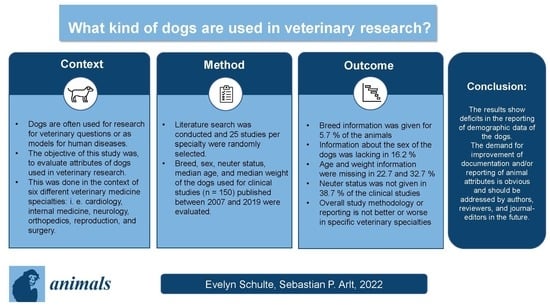What Kinds of Dogs Are Used in Clinical and Experimental Research?
Abstract
:Simple Summary
Abstract
1. Introduction
2. Material and Methods
Statistical Analysis
3. Results
3.1. Sex of the Dog Population
3.2. Age of the Study Population
3.3. Weight of the Dogs
3.4. Origin of Study Population and Overall Number of Animals
4. Discussion
Limitations
5. Conclusions
Author Contributions
Funding
Institutional Review Board Statement
Informed Consent Statement
Data Availability Statement
Acknowledgments
Conflicts of Interest
References
- Balls, M. Scientific Issues Raised by the Use of Dogs as Laboratory Animals. Atla-Altern Lab. Anim. 2016, 44, 1–4. [Google Scholar] [CrossRef] [PubMed] [Green Version]
- Taylor, K.; Gordon, N.; Langley, G.; Higgins, W. Estimates for worldwide laboratory animal use in 2005. Altern. Lab. Anim. 2008, 36, 327–342. [Google Scholar] [CrossRef] [PubMed] [Green Version]
- Taylor, K.; Alvarez, L.R. An Estimate of the Number of Animals Used for Scientific Purposes Worldwide in 2015. Altern. Lab. Anim. 2019, 47, 196–213. [Google Scholar] [CrossRef] [PubMed]
- Petetta, F.; Ciccocioppo, R. Public perception of laboratory animal testing: Historical, philosophical, and ethical view. Addict. Biol. 2021, 26, e12991. [Google Scholar] [CrossRef] [PubMed]
- Speaking of Research. US Animal Research Statistics. Available online: https://speakingofresearch.com/facts/statistics/ (accessed on 19 February 2022).
- European Commission. Summary Report on the Statistics on the Use of Animals for Scientific Purposes in the Member States of the European Union and Norway in 2018. Commission Staff Working Document. 2021. Available online: https://ec.europa.eu/environment/chemicals/lab_animals/pdf/SWD_%20part_A_and_B.pdf (accessed on 20 May 2022).
- Rossi, G.; Rossi, M.; Vitali, C.G.; Fortuna, D.; Burroni, D.; Pancotto, L.; Capecchi, S.; Sozzi, S.; Renzoni, G.; Braca, G.; et al. A conventional beagle dog model for acute and chronic infection with Helicobacter pylori. Infect. Immun. 1999, 67, 3112–3120. [Google Scholar] [CrossRef] [Green Version]
- Hytonen, M.K.; Lohi, H. Canine models of human rare disorders. Rare Dis. 2016, 4, e1241362. [Google Scholar] [CrossRef] [Green Version]
- Shearin, A.L.; Ostrander, E.A. Leading the way: Canine models of genomics and disease. Dis. Model Mech. 2010, 3, 27–34. [Google Scholar] [CrossRef] [Green Version]
- Bolman, B. Dogs for Life: Beagles, Drugs, and Capital in the Twentieth Century. J. Hist. Biol. 2022, 55, 147–179. [Google Scholar] [CrossRef] [PubMed]
- Hasiwa, N.; Bailey, J.; Clausing, P.; Daneshian, M.; Eileraas, M.; Farkas, S.; Gyertyan, I.; Hubrecht, R.; Kobel, W.; Krummenacher, G.; et al. Critical evaluation of the use of dogs in biomedical research and testing in Europe. ALTEX 2011, 28, 326–340. [Google Scholar] [CrossRef] [Green Version]
- Giraud, E.; Hollin, G. Care, Laboratory Beagles and Affective Utopia. Theory Cult. Soc. 2016, 33, 27–49. [Google Scholar] [CrossRef]
- Fédération Cynologique Internationale. Presentation of Our Organisation. Available online: http://www.fci.be/en/Presentation-of-our-organisation-4.html (accessed on 30 January 2022).
- The American Kennel Club. Most Popular Dog Breeds. Available online: https://www.akc.org/most-popular-breeds/ (accessed on 8 January 2022).
- The American Kennel Club. The Most Popular Dog Breeds of 2019. Available online: https://www.akc.org/most-popular-breeds/2019-full-list/ (accessed on 21 May 2022).
- Albert, R.E.; Benjamin, S.A.; Shukla, R. Life span and cancer mortality in the beagle dog and humans. Mech. Ageing Dev. 1994, 74, 149–159. [Google Scholar] [CrossRef]
- Tromp, J.A.; Jansen, J.; Pilot, T. Gingival health and frequency of tooth brushing in the beagle dog model. Clinical findings. J. Clin. Periodontol. 1986, 13, 164–168. [Google Scholar] [CrossRef] [PubMed]
- Sargeant, J.M.; O’Connor, A.M. Issues of reporting in observational studies in veterinary medicine. Prev. Vet. Med. 2014, 113, 323–330. [Google Scholar] [CrossRef]
- Skelly, A.C.; Dettori, J.R.; Brodt, E.D. Assessing bias: The importance of considering confounding. Evid. Based Spine Care J. 2012, 3, 9–12. [Google Scholar] [CrossRef] [PubMed] [Green Version]
- Hart, B.L.; Hart, L.A.; Thigpen, A.P.; Willits, N.H. Assisting Decision-Making on Age of Neutering for Mixed Breed Dogs of Five Weight Categories: Associated Joint Disorders and Cancers. Front. Vet. Sci. 2020, 7, 472. [Google Scholar] [CrossRef] [PubMed]
- Comerford, E.J.; Smith, K.; Hayashi, K. Update on the aetiopathogenesis of canine cranial cruciate ligament disease. Vet. Comp. Orthop. Traumatol. 2011, 24, 91–98. [Google Scholar] [CrossRef] [Green Version]
- Puurunen, J.; Ottka, C.; Salonen, M.; Niskanen, J.E.; Lohi, H. Age, breed, sex and diet influence serum metabolite profiles of 2000 pet dogs. R. Soc. Open Sci. 2022, 9, 211642. [Google Scholar] [CrossRef]
- Wallis, C.; Holcombe, L.J. A review of the frequency and impact of periodontal disease in dogs. J. Small Anim. Pract. 2020, 61, 529–540. [Google Scholar] [CrossRef]
- Jitpean, S.; Hagman, R.; Strom Holst, B.; Hoglund, O.V.; Pettersson, A.; Egenvall, A. Breed variations in the incidence of pyometra and mammary tumours in Swedish dogs. Reprod. Domest. Anim. 2012, 47 (Suppl. S6), 347–350. [Google Scholar] [CrossRef]
- Wess, G.; Domenech, O.; Dukes-McEwan, J.; Haggstrom, J.; Gordon, S. European Society of Veterinary Cardiology screening guidelines for dilated cardiomyopathy in Doberman Pinschers. J. Vet. Cardiol. Off. J. Eur. Soc. Vet. Cardiol. 2017, 19, 405–415. [Google Scholar] [CrossRef]
- Craven, M.; Mansfield, C.S.; Simpson, K.W. Granulomatous colitis of boxer dogs. Vet. Clin. N. A. Small Anim. Pract. 2011, 41, 433–445. [Google Scholar] [CrossRef] [PubMed]
- Millan, Y.; Guil-Luna, S.; Reymundo, C.; Sanchez, R.; de las Mulas, J.M. Sex Steroid Hormones and Tumors in Domestic Animals. In Insights from Veterinary Medicine; IntechOpen: London, UK, 2013. [Google Scholar]
- Greco, D.S. Hyperadrenocorticism associated with sex steroid excess. Clin. Tech. Small Anim. Pract. 2007, 22, 12–17. [Google Scholar] [CrossRef]
- Schulte, E.; Arlt, S.P. Study design quality of research on dogs published in peer-reviewed journals. Vet. Rec. 2022, 190, e1382. [Google Scholar] [CrossRef] [PubMed]
- Arlt, S.; Dicty, V.; Heuwieser, W. Evidence-based medicine in canine reproduction: Quality of current available literature. Reprod. Domest. Anim. 2010, 45, 1052–1058. [Google Scholar] [CrossRef] [PubMed]
- Statista. Leading 20 Dog Breeds in the United Kingdom (UK) in 2020, Based on Number of Registrations. Available online: https://www.statista.com/statistics/915202/top-dog-breeds-by-registered-number-united-kingdom-uk/ (accessed on 21 May 2022).
- Home Office. Annual Statistics of Scientific Procedures on Living Animals Great Britain 2020. Available online: https://assets.publishing.service.gov.uk/government/uploads/system/uploads/attachment_data/file/1002895/annual-statistics-scientific-procedures-living-animals-2020.pdf (accessed on 20 May 2022).
- Wadman, M. Leading Breeder of Beagles for Research Slammed by Animal Welfare Inspectors. Available online: https://www.science.org/content/article/leading-breeder-beagles-research-slammed-animal-welfare-inspectors (accessed on 30 January 2022).
- Hanninen, L.; Norring, M. The First Rehoming of Laboratory Beagles in Finland: The Complete Process from Socialisation Training to Follow-up. Altern. Lab. Anim. 2020, 48, 116–126. [Google Scholar] [CrossRef]
- Döhring, D.; Erhard, M.H. Verbleib von überzähligen und überlebenden Versuchstieren. ALTEX—Altern Tierexp 2005, 22, 7–11. [Google Scholar]
- Doring, D.; Nick, O.; Bauer, A.; Kuchenhoff, H.; Erhard, M.H. How do rehomed laboratory beagles behave in everyday situations? Results from an observational test and a survey of new owners. PLoS ONE 2017, 12, e0181303. [Google Scholar] [CrossRef] [Green Version]
- Doring, D.; Nick, O.; Bauer, A.; Kuchenhoff, H.; Erhard, M.H. Behavior of laboratory dogs before and after rehoming in private homes. ALTEX-Altern. Anim. Exp. 2017, 34, 133–147. [Google Scholar] [CrossRef] [Green Version]
- Cuschieri, S. The STROBE guidelines. Saudi J. Anaesth. 2019, 13, S31–S34. [Google Scholar] [CrossRef]
- Reynolds, P.S.; Garvan, C.W. Preclinical Research Reporting in Shock: Room for Improvement. Shock 2021, 55, 573–580. [Google Scholar] [CrossRef]
- Haimerl, P.; Arlt, S.P.; Heuwieser, W. Evidence-based medicine: Quality and comparability of clinical trials investigating the efficacy of prostaglandin F(2alpha) for the treatment of bovine endometritis. J. Dairy Res. 2012, 79, 287–296. [Google Scholar] [CrossRef] [PubMed] [Green Version]
- Simoneit, C.; Heuwieser, W.; Arlt, S.P. Evidence-based medicine in bovine, equine and canine reproduction: Quality of current literature. Theriogenology 2011, 76, 1042–1050. [Google Scholar] [CrossRef] [PubMed]
- Fontbonne, A. Small animal reproduction: Scientific facts versus dogmas or unverified beliefs. Theriogenology 2020, 150, 464–470. [Google Scholar] [CrossRef] [PubMed]
- Lerdweeraphon, W.; Thanwongsa, S.; Youyod, S.; Imsopa, S.; Kenchaiwong, W. The effects of breed, age, sex, and body weight on electrocardiographic parameters in military working dogs. Vet. World 2020, 13, 1001–1004. [Google Scholar] [CrossRef] [PubMed]
- Tesi, M.; Lazzarini, G.; Magliaro, C.; Abramo, F.; Fanelli, D.; Miragliotta, V.; Rota, A. Age-related changes of seminiferous tubule morphology, interstitial fibrosis and spermatogenesis in dogs. Anim. Reprod. Sci. 2020, 219, 106534. [Google Scholar] [CrossRef] [PubMed]
- Wallis, L.J.; Szabo, D.; Kubinyi, E. Cross-Sectional Age Differences in Canine Personality Traits; Influence of Breed, Sex, Previous Trauma, and Dog Obedience Tasks. Front. Vet. Sci. 2019, 6, 493. [Google Scholar] [CrossRef] [PubMed] [Green Version]
- Saunders, A.B. The diagnosis and management of age-related veterinary cardiovascular disease. Vet. Clin. N. A. Small Anim. Pract. 2012, 42, 655–668. [Google Scholar] [CrossRef]
- Mizukami, K.; Uchiyama, J.; Igarashi, H.; Murakami, H.; Osumi, T.; Shima, A.; Ishiahra, G.; Nasukawa, T.; Une, Y.; Sakaguchi, M. Age-related analysis of the gut microbiome in a purebred dog colony. FEMS Microbiol. Lett. 2019, 366, 1–7. [Google Scholar] [CrossRef]
- Kim, H.W.; Lim, H.Y.; Shin, J.I.; Seung, B.J.; Ju, J.H.; Sur, J.H. Breed- and age-related differences in canine mammary tumors. Can. J. Vet. Res. 2016, 80, 146–155. [Google Scholar]
- Belic, M.; Kusec, V.; Svetina, A.; Grizelj, J.; Robic, M.; Vrbanac, Z.; Benic, M.; Turk, R. The influence of sex on biochemical markers of bone turnover in dogs. Res. Vet. Sci. 2012, 93, 918–920. [Google Scholar] [CrossRef]
- Grierson, J.; Asher, L.; Grainger, K. An investigation into risk factors for bilateral canine cruciate ligament rupture. Vet. Comp. Orthop. Traumatol. 2011, 24, 192–196. [Google Scholar] [CrossRef] [PubMed]
- Reichler, I.M. Gonadectomy in cats and dogs: A review of risks and benefits. Reprod. Domest. Anim. 2009, 44 (Suppl. S2), 29–35. [Google Scholar] [CrossRef] [PubMed] [Green Version]
- Torres de la Riva, G.; Hart, B.L.; Farver, T.B.; Oberbauer, A.M.; Messam, L.L.; Willits, N.; Hart, L.A. Neutering dogs: Effects on joint disorders and cancers in golden retrievers. PLoS ONE 2013, 8, e55937. [Google Scholar] [CrossRef] [PubMed]
- Tsai, S.; Bentley, E.; Miller, P.E.; Gomes, F.E.; Vangyi, C.; Wiese, A.; Almazan, A.; Li, H.; Conforti, P.; Lee, S.S.; et al. Gender differences in iridocorneal angle morphology: A potential explanation for the female predisposition to primary angle closure glaucoma in dogs. Vet. Ophthalmol. 2012, 15 (Suppl. S1), 60–63. [Google Scholar] [CrossRef]
- Lobacz, M.A.; Sullivan, M.; Mellor, D.; Hammond, G.; Labruyere, J.; Dennis, R. Effect of breed, age, weight and gender on radiographic renal size in the dog. Vet. Radiol. Ultrasound 2012, 53, 437–441. [Google Scholar] [CrossRef]
- Fleischer, S.; Sharkey, M.; Mealey, K.; Ostrander, E.A.; Martinez, M. Pharmacogenetic and metabolic differences between dog breeds: Their impact on canine medicine and the use of the dog as a preclinical animal model. AAPS J. 2008, 10, 110–119. [Google Scholar] [CrossRef] [Green Version]
- Donner, J.; Anderson, H.; Davison, S.; Hughes, A.M.; Bouirmane, J.; Lindqvist, J.; Lytle, K.M.; Ganesan, B.; Ottka, C.; Ruotanen, P.; et al. Frequency and distribution of 152 genetic disease variants in over 100,000 mixed breed and purebred dogs. PLoS Genet. 2018, 14, e1007361. [Google Scholar] [CrossRef]
- Firdova, Z.; Turnova, E.; Bielikova, M.; Turna, J.; Dudas, A. The prevalence of ABCB1:c.227_230delATAG mutation in affected dog breeds from European countries. Res. Vet. Sci. 2016, 106, 89–92. [Google Scholar] [CrossRef]
- Di Girolamo, N.; Meursinge Reynders, R. Deficiencies of effectiveness of intervention studies in veterinary medicine: A cross-sectional survey of ten leading veterinary and medical journals. PeerJ 2016, 4, 1–22. [Google Scholar] [CrossRef] [PubMed] [Green Version]
- Johansen, M.; Thomsen, S.F. Guidelines for Reporting Medical Research: A Critical Appraisal. Int. Sch. Res. Not. 2016, 2016, 1346026. [Google Scholar] [CrossRef] [Green Version]
- Balls, M.; Bailey, J.; Combes, R.D. How viable are alternatives to animal testing in determining the toxicities of therapeutic drugs? Expert Opin. Drug Metab. Toxicol. 2019, 15, 985–987. [Google Scholar] [CrossRef] [PubMed]
- Liebsch, M.; Grune, B.; Seiler, A.; Butzke, D.; Oelgeschlager, M.; Pirow, R.; Adler, S.; Riebeling, C.; Luch, A. Alternatives to animal testing: Current status and future perspectives. Arch. Toxicol. 2011, 85, 841–858. [Google Scholar] [CrossRef] [PubMed] [Green Version]
- Madden, J.C.; Enoch, S.J.; Paini, A.; Cronin, M.T.D. A Review of In Silico Tools as Alternatives to Animal Testing: Principles, Resources and Applications. Altern. Lab. Anim. 2020, 48, 146–172. [Google Scholar] [CrossRef]
- Akkermans, A.; Chapsal, J.M.; Coccia, E.M.; Depraetere, H.; Dierick, J.F.; Duangkhae, P.; Goel, S.; Halder, M.; Hendriksen, C.; Levis, R.; et al. Animal testing for vaccines. Implementing replacement, reduction and refinement: Challenges and priorities. Biologicals 2020, 68, 92–107. [Google Scholar] [CrossRef]
- Leist, M.; Hasiwa, N.; Rovida, C.; Daneshian, M.; Basketter, D.; Kimber, I.; Clewell, H.; Gocht, T.; Goldberg, A.; Busquet, F.; et al. Consensus report on the future of animal-free systemic toxicity testing. ALTEX 2014, 31, 341–356. [Google Scholar] [CrossRef] [PubMed] [Green Version]
- Sannmann, I.; Arlt, S.P.; Heuwieser, W. A critical evaluation of diagnostic methods used to identify dairy cows with acute post-partum metritis in the current literature. J. Dairy Res. 2012, 79, 436–444. [Google Scholar] [CrossRef]
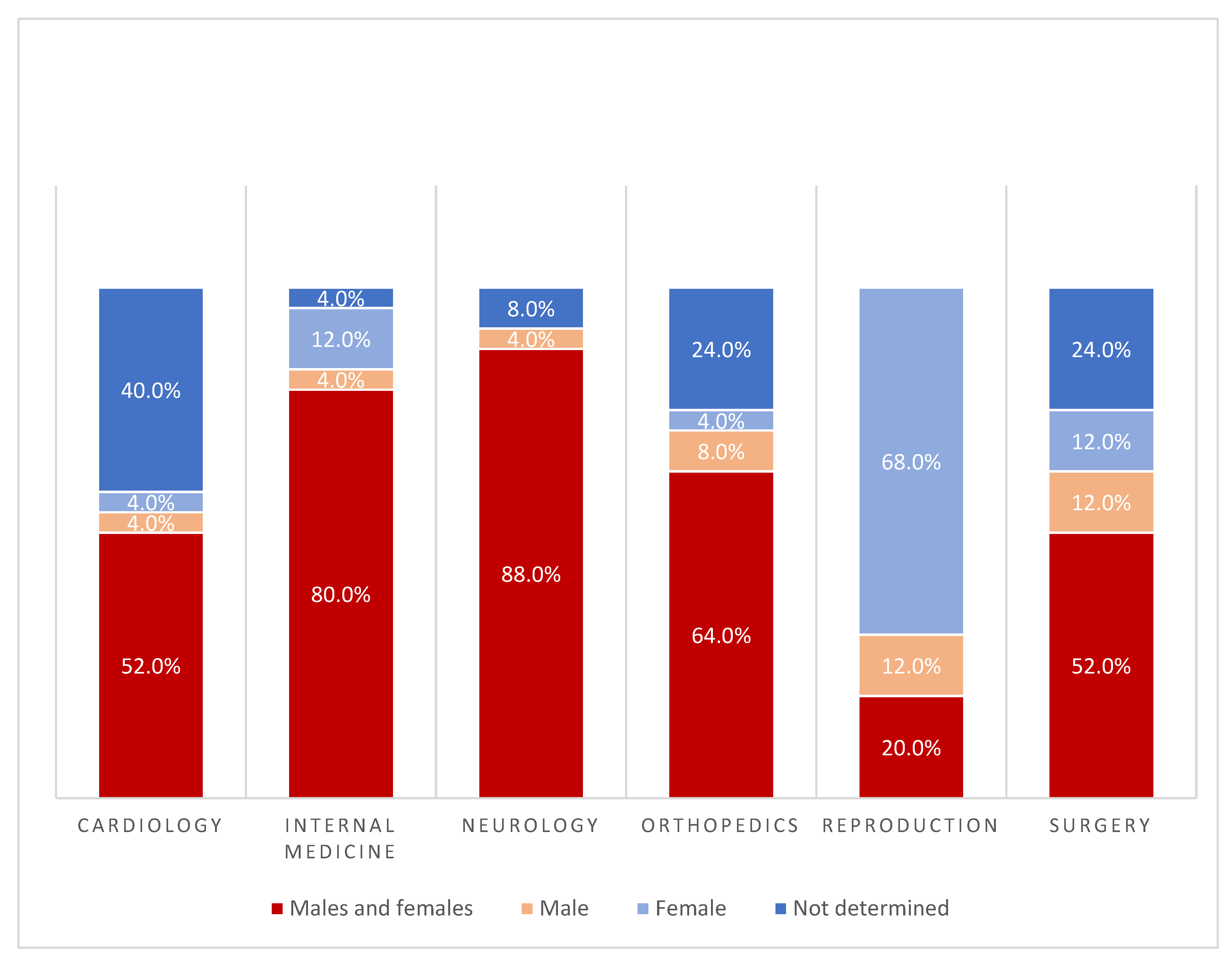
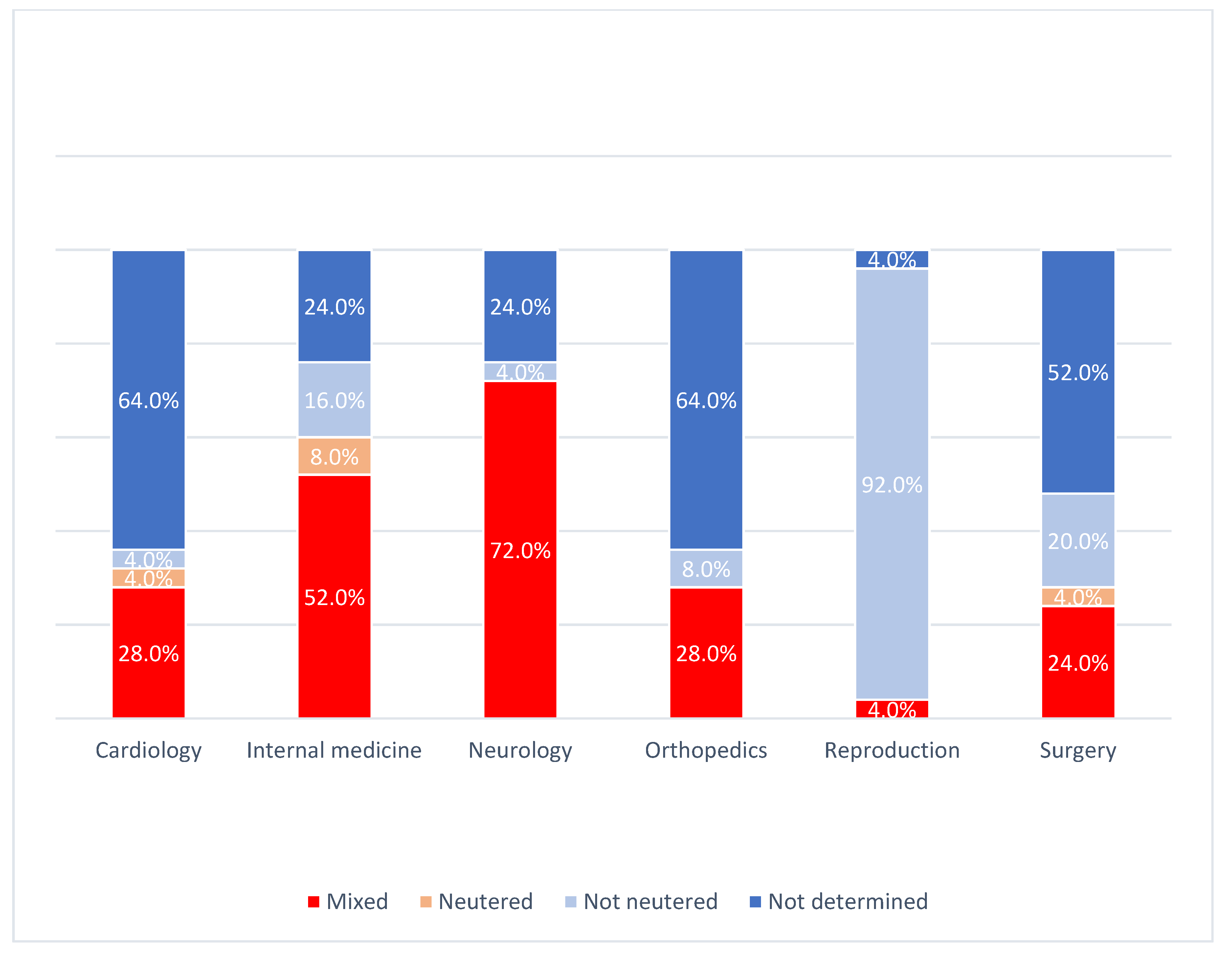
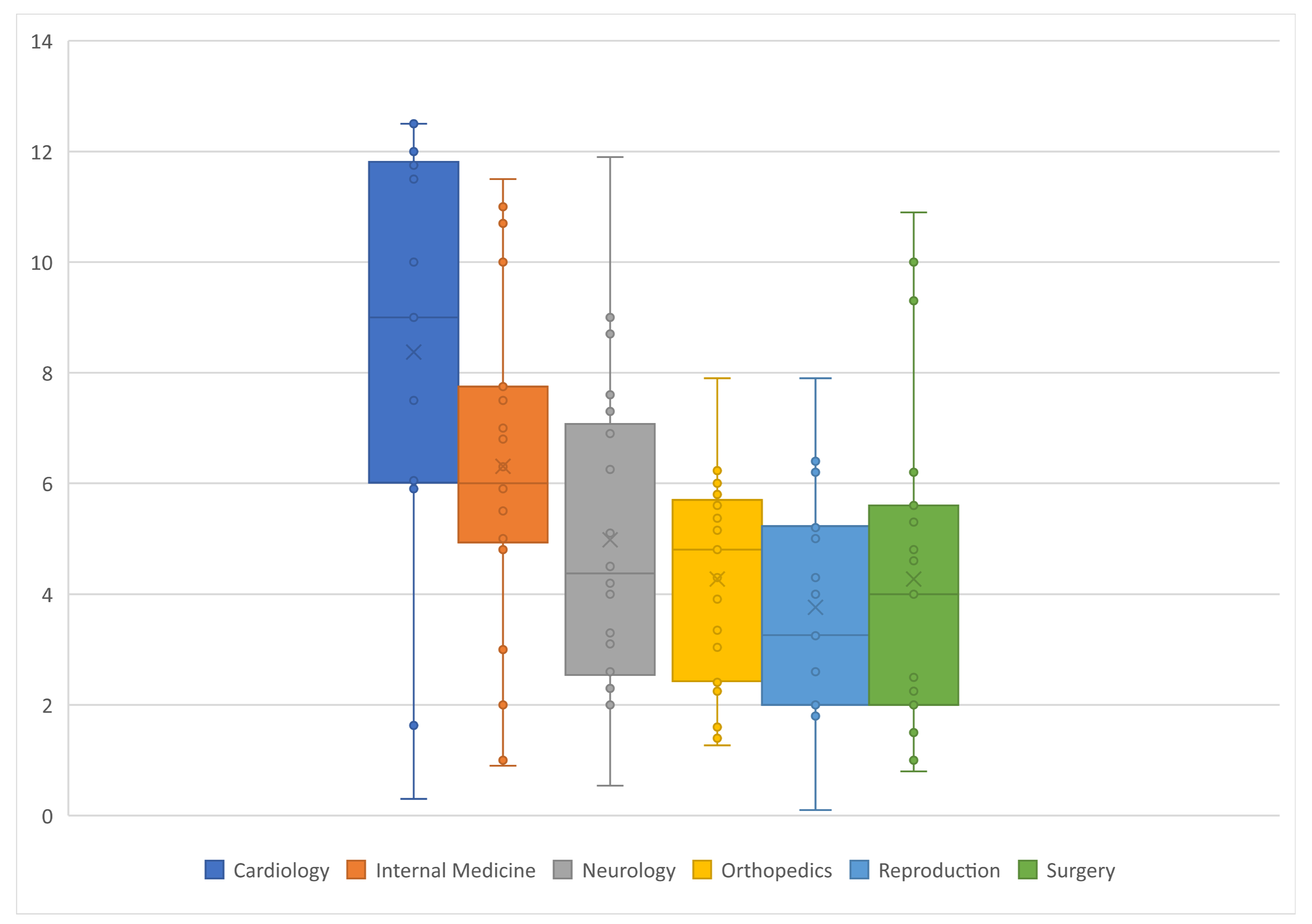
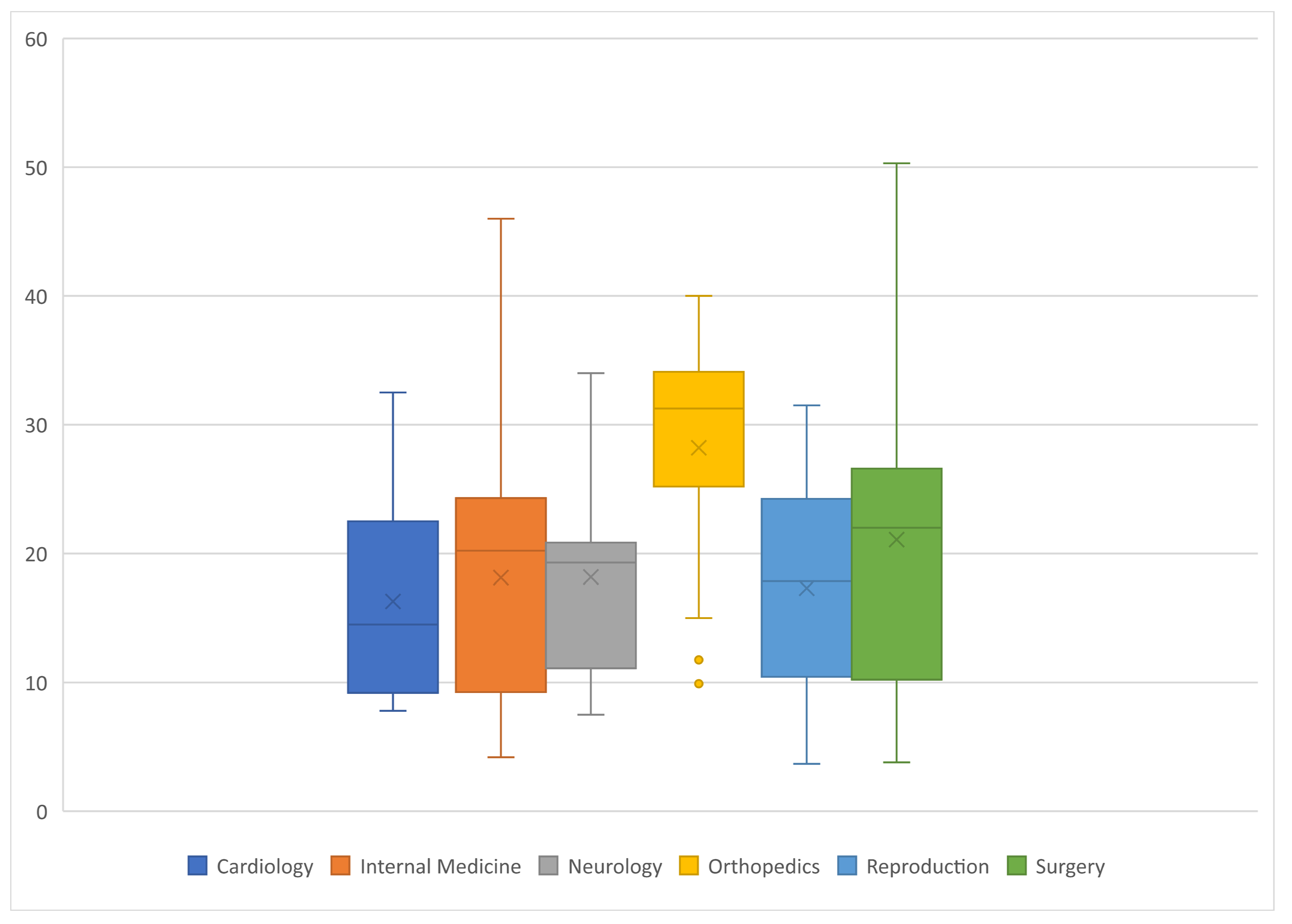
| Dog Breed | 2019 Rank | Number of Publications Between 2007 and 2019 Resulting from the Breed Used as a Search Term in PubMed in May 2022 |
|---|---|---|
| Labrador Retriever | 1 | 824 |
| German Shepherd | 2 | 625 |
| Golden Retriever | 3 | 551 |
| French Bulldog | 4 | 115 |
| Bulldog | 5 | 488 |
| Poodle | 6 | 243 |
| Beagle | 7 | 5.199 |
| Rottweiler | 8 | 214 |
| German Shorthaired Pointer | 9 | 45 |
| Pembroke Welsh Corgi | 10 | 49 |
| Specialty | Number of Studies (n = 25 per Specialty) | |
|---|---|---|
| Using Beagles | With Missing Breed Information | |
| Cardiology | 4 (16.0%) | 7 (28.0%) |
| Internal medicine | 8 (32.0%) | 10 (40.0%) |
| Neurology | 5 (20.0%) | 5 (20.0%) |
| Orthopaedics | 4 (16.0%) | 10 (40.0%) |
| Reproduction | 3 (12.0%) | 8 (32.0%) |
| Surgery | 8 (32.0%) | 6 (24.0%) |
| Total | 32 (21.3%) | 46 (30.7%) |
| Specialty | Total Number of Dogs per Specialty (25 Studies) | Total Number of Dogs with Breed Specification | Proportion of Beagles in Relation to All Dogs with Known Breed |
|---|---|---|---|
| Cardiology | 3319 | 850 | 4.4% |
| Internal medicine | 24,696 | 286 | 12.9% |
| Neurology | 2004 | 639 | 2.0% |
| Orthopaedics | 433,347 | 784 | 5.6% |
| Reproduction | 102,104 | 744 | 0.4% |
| Surgery | 31,072 | 30,532 | 1.2% |
| Total | 596,542 | 33,835 | 1.9% |
| Dog Breed | Number (and Percentage) of Dogs of the US Top Ten Breeds of 2019 Used in 150 Clinical Trials |
|---|---|
| Labrador Retriever | 2828 (6.7%) |
| German Shepherd | 3055 (7.3%) |
| Golden Retriever | 1780 (4.7%) |
| French Bulldog | 51 (0.1%) |
| Bulldog | 46 (0.1%) |
| Poodle | 750 (1.8%) |
| Beagle | 640 (1.5%) |
| Rottweiler | 1228 (2.9) |
| German Shorthaired Pointer | 78 (0.1%) |
| Pembroke Welsh Corgi | 1 (0.002%) |
Publisher’s Note: MDPI stays neutral with regard to jurisdictional claims in published maps and institutional affiliations. |
© 2022 by the authors. Licensee MDPI, Basel, Switzerland. This article is an open access article distributed under the terms and conditions of the Creative Commons Attribution (CC BY) license (https://creativecommons.org/licenses/by/4.0/).
Share and Cite
Schulte, E.; Arlt, S.P. What Kinds of Dogs Are Used in Clinical and Experimental Research? Animals 2022, 12, 1487. https://doi.org/10.3390/ani12121487
Schulte E, Arlt SP. What Kinds of Dogs Are Used in Clinical and Experimental Research? Animals. 2022; 12(12):1487. https://doi.org/10.3390/ani12121487
Chicago/Turabian StyleSchulte, Evelyn, and Sebastian P. Arlt. 2022. "What Kinds of Dogs Are Used in Clinical and Experimental Research?" Animals 12, no. 12: 1487. https://doi.org/10.3390/ani12121487
APA StyleSchulte, E., & Arlt, S. P. (2022). What Kinds of Dogs Are Used in Clinical and Experimental Research? Animals, 12(12), 1487. https://doi.org/10.3390/ani12121487





